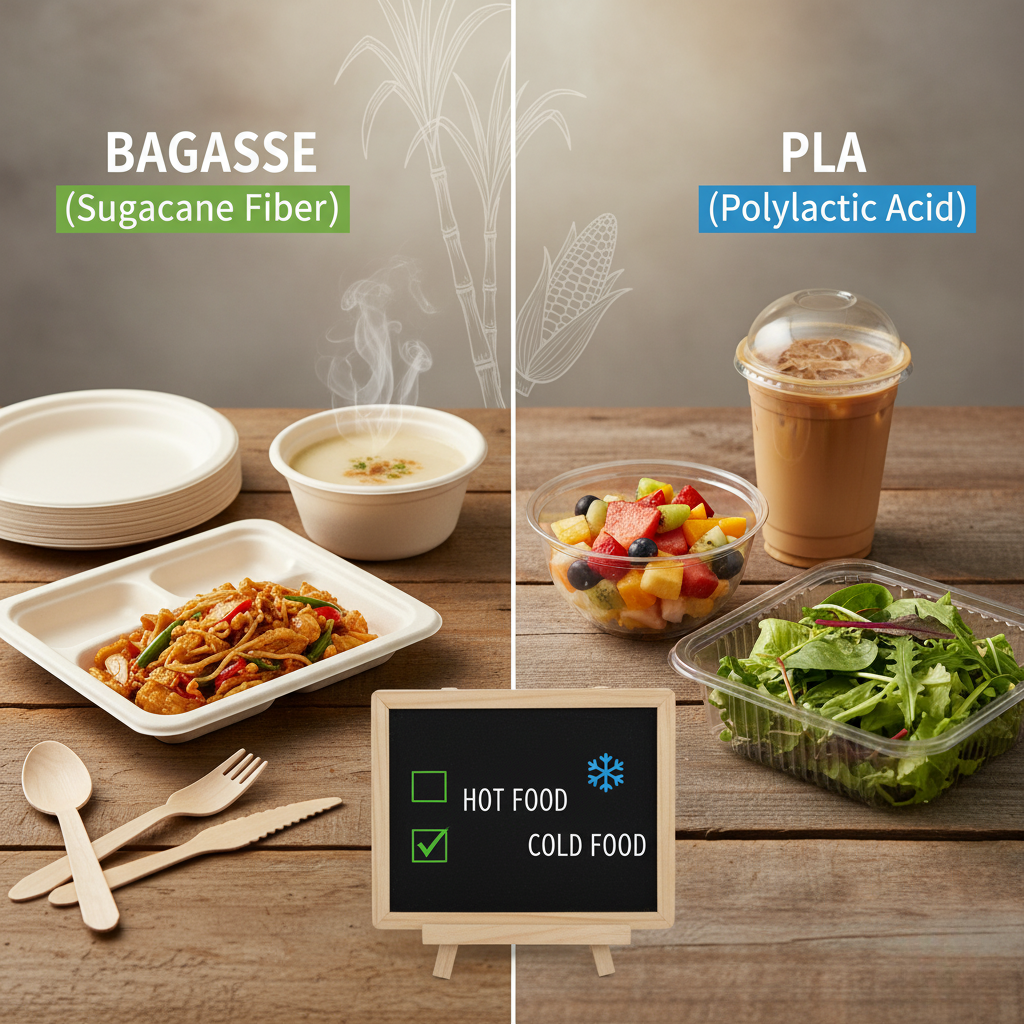
Bagasse vs. PLA: A Head-to-Head Comparison for Eco-Friendly Disposables
Share
Switching from plastic is the first step toward sustainability, but not all eco-friendly alternatives are created equal. When choosing the right disposable packaging for your business, you'll inevitably encounter two industry leaders: Bagasse (sugarcane fiber) and PLA (Polylactic Acid).
Both materials are plant-based and compostable, yet their performance, disposal requirements, and ideal use cases differ significantly. Understanding these distinctions is crucial for making a choice that truly aligns with your menu, your operations, and your sustainability goals.
Here is a head-to-head comparison of Bagasse and PLA packaging:
The Material & Source: What Are They Made Of?
| Feature | 🟢 Sugarcane Bagasse | 🔵 PLA (Polylactic Acid) |
| Raw Material | Fibrous residue left after sugarcane is crushed (an agricultural waste byproduct). | Fermented starch from plants, typically corn or cassava (a virgin resource). |
| Resource Impact | Circular Economy Champion: Repurposes existing waste, requiring no extra land, water, or crops for its raw material. | Resource-Intensive: Requires farmland and agricultural resources (fertilizers, water, etc.) to grow the feedstock crop. |
| Appearance | Opaque, natural, fibrous, and paper-like texture. Commonly used for plates, bowls, and clamshells. | Clear, smooth, and rigid, closely resembling traditional petroleum-based plastic. Used for clear cups, cold lids, and clear containers. |
Key Takeaway: Bagasse scores higher on the raw material front because it is an upcycled, zero-waste byproduct, whereas PLA relies on specially grown crops.
Performance: Hot, Cold, and Durability
The material's reaction to temperature is the most critical difference for foodservice applications.
| Feature | 🟢 Sugarcane Bagasse | 🔵 PLA (Polylactic Acid) |
| Heat Resistance | Excellent. Withstands temperatures up to 200°F (93°C). Ideal for hot food, soups, and entrees. | Poor. Begins to warp and soften at temperatures above 110°F (43°C). Unsuitable for hot drinks or hot food. |
| Microwave Safe | Yes. Can be used for reheating food. | No. High heat will cause it to melt or deform. |
| Grease & Water | Very Good. Highly resistant to grease and water, maintaining its structure with saucy and oily foods. | Good. Effective for short-term containment, but not ideal for lengthy contact with very hot or greasy items. |
| Durability | Sturdy. Fibrous composition provides high strength and rigidity, resisting bending and cracking under the weight of heavy meals. | Brittle. While rigid, it can be prone to cracking, especially when exposed to temperature extremes. |
Key Takeaway: Bagasse is the superior choice for all hot food, takeout, and meal prep applications where high durability and heat resistance are non-negotiable.2 PLA is best reserved for exclusively cold-serving applications.
Compostability and End-of-Life
This is the most critical factor defining whether a product truly delivers on its eco-promise.
| Feature | 🟢 Sugarcane Bagasse | 🔵 PLA (Polylactic Acid) |
| Composting Requirement | Industrial & Home Compostable. Requires minimal specific conditions to break down. | Industrial Compostable ONLY. Requires the sustained high heat and specific microbial balance of a commercial composting facility. |
| Decomposition Time | Decomposes rapidly, typically within 60–90 days in a commercial facility. | Decomposes within 90–180 days in a commercial facility. |
| Landfill Fate | Will break down faster than PLA, though still slower than in a compost pile. | Behaves like conventional plastic, sitting in a landfill for years and taking an extremely long time to degrade. |
Key Takeaway: Bagasse offers a much lower risk of ending up as long-term waste.4 Its ability to break down in home or less-perfect composting environments makes its environmental guarantee more robust.
Final Verdict: Choosing the Right Disposable
There is no single "best" material; the best choice is the one that fits your specific business needs while minimizing environmental impact.
| If your menu is primarily... | Go with Bagasse 🟢 | Consider PLA 🔵 |
| Hot Entrees, Soups, Burgers | The Best Choice. Provides necessary heat and grease resistance. | Avoid. Will warp and fail under heat. |
| Cold Salads, Desserts, Fruit | A reliable and strong option, often preferred for its natural feel. | The Best Choice. Offers crystal clarity for presentation and is perfectly suited for cold temperatures. |
| Goal is Max. Environmental Impact | The Winner. Made from agricultural waste and is more widely compostable. | Only if you are certain your customers/waste hauler use an industrial facility. |
| Need for Transparency | Not Available. Bagasse is always opaque. | The Winner. Ideal for showing off food presentation. |
By prioritizing your operational needs—especially temperature tolerance—you can choose between the versatility and purity of Bagasse and the visual clarity of PLA, ensuring your sustainable commitment is successful from kitchen to compost.
